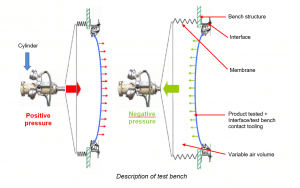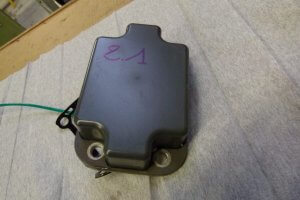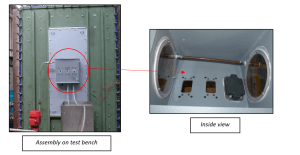Materials Resistance to Positive and Negative Pressure Conditions
In numerous fields, such as the rail, aeronautics and construction sectors, materials and particularly windows may be subjected to significant positive and negative pressure waves. It is essential that such equipment and the materials they are made from be tested to ensure that they are fit for purpose.
You want to consult or share the case study in PDF format?
Materials Resistance and Air/Water Tightness
Eurailtest’s partner laboratory, the Railway Test Agency (AEF), has a positive/negative pressure test bench which is used to check the resistance of materials to such conditions and to monitor their air/water tightness.
This test bench is primarily used to test glazing and check the resistance of glass and other components (screwed fixings, adhesive, joints, etc.) by simulating different configurations. These tests can also be conducted on all types of equipment likely to be subjected to positive/negative pressure waves. This is especially true for parts installed on the front and side surfaces of a train, such as headlights, Wi-Fi antennas, doors, etc.
Additionally, this test bench can be used to conduct research on the causes of failure or wear on certain parts.
Positive/Negative Pressure Tests on Windows
The AEF’s positive/negative pressure test bench is used mainly to test glazing installed on different railway structures. In compliance with a strict protocol, glazing is subjected to repeat cycles of positive and negative pressures to test its durability over time.
Glass parts onboard trains are subjected to considerable pressure when entering a tunnel or when two trains pass at high speed. They must not present any failures in terms of their insulating function.
The benefit of testing glazing on a test bench is the ability to reproduce real-life conditions and analyse the behaviour and resistance of all components simultaneously. Positive/negative pressure conditions are reproduced using a membrane driven by a cylinder and a spraying system can also be used to check the water tightness of equipment tested.
- Air tightness: positive/negative pressure waves are simulated to represent those caused during service, when trains pass one another or enter tunnels.
- Water tightness: during service, materials are subjected to weather conditions such as rain. During the positive/negative pressure tests, a spraying system can be used to check the water tightness of the assembly tested.

Tests Performed on External Parts of a Train Structure
Other components installed on the external parts of trains are subjected to positive and negative pressure conditions. The resistance, insulation and air/water tightness of this equipment can be tested in the same way on the test bench.
Example: positive/negative pressure tests on Wi-Fi antennas

In 2016, trains were equipped with a Wi-Fi antenna to offer a new service to passengers. These antennas are installed on the train roof. They were tested on the AEF test bench to check their air and water tightness under positive/negative pressure fluctuations during service.
To test the antennas, the AEF Fatigue and Design Office teams designed tooling to enable assembly on the test bench. If requested by the customer, a spraying system can be installed and changes in pressure inside the antennas can be measured.

Other components such as headlights on the front of trains as well as side doors can be tested in this way.
Research and Analysis of The Causes of Failure and Wear
Drawing on their technical resources and expertise, our AEF teams can also conduct research on the causes of failures observed on materials subjected to positive and negative pressure conditions.
A specific request to the AEF team was to conduct research following the failure of a TGV window and identify the origin of the problem. The detachment of a windowpane may be linked to the adhesive used to hold the glass in place or other mounting hardware such as nuts and bolts, screws, frame, etc. The purpose of the tests is therefore to reproduce conditions that are more or less extreme and to analyse all of the components in order to understand the origin of premature wear, for example.
Characteristics of the AEF Positive/Negative Pressure Test Bench
This AEF test bench was built in 1980 and continues to prove its effectiveness. It can accommodate parts with dimensions of up to 1,800 mm x 2,500 mm. A feasibility study is conducted in accordance with the item tested.
The AEF sets up/performs customised tests in consultation with its customers.
The test bench can reproduce positive/negative pressure of up to +/- 8,000 Pa (Pascal). The pressure signals generated from measurements conducted online are adjusted to meet customer requirements, specifications and standards.
Tests can be conducted in compliance with the following standards:
- NF F31-129 − Tempered safety glass
- NF EN 1279-2 − Insulating glass units – Part 2: Long-term test method and requirements for moisture penetration
- UIC 566 − Fatigue tests
- NF F01-492 − Railway rolling stock – Windows:
– Water tightness tests
– Soft body impact resistance tests
– Positive/negative pressure fluctuation resistance tests
– Bonding strength fracture resistance tests
– Climatic ageing cycle resistance tests
Other tests can also be conducted depending on customer requirements and specifications.
Numerous configurations and conditions can be reproduced on the test bench, making it possible to conduct tests on different types of parts and for different economic sectors (aeronautics, automotive, construction, etc.).





